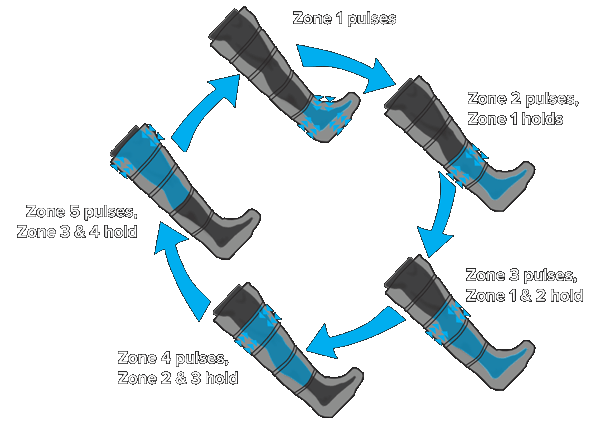Speak to a Recovery Expert today
About the NormaTec Pulse Technology
What is NormaTec?
NormaTec is the leader in rapid recovery—our systems give a competitive edge to the world’s elite athletes, coaches, and trainers. Our goal is to establish recovery as an integral part of every athlete’s training, and we feel NormaTec systems are the best way to accomplish that. The NormaTec PULSE Recovery Systems are dynamic compression devices designed for recovery and rehab. All of our systems use NormaTec's patented PULSE technology to help athletes recover faster between trainings and after performance.
Our systems include a control unit and attachments which go on the legs, arms, or hips. They use compressed air to massage your limbs, mobilise fluid, and speed recovery with our patented NormaTec Pulse Massage Pattern. When you use our systems, you will first experience a pre-inflate cycle, during which the connected attachments are moulded to your exact body shape. The session will then begin by compressing your feet, hands, or upper quad (depending on which attachment you are using). Similar to the kneading and stroking done during a massage, each segment of the attachment will first compress in a pulsing manner and then release. This will repeat for each segment of the attachment as the compression pattern works its way up your limb.
The NormaTec Pulse Massage Pattern

The NormaTec Pulse Massage Pattern starts in the foot, hand, or lower hip and moves upwards zone-by-zone massaging the limb and mobilizing fluid out of the extremities.
Created by a physician bioengineer (MD, PhD) to enhance blood flow and speed recovery, NormaTec Pulse Massage Pattern employs three key techniques to maximize your recovery:
PULSING: Instead of using static compression (squeezing) to transport fluid out of the limbs, Sequential Pulse Technology uses dynamic compression (pulsing). Our patented pulsing action more effectively mimics the muscle pump of the legs and arms, greatly enhancing the movement of fluid and metabolites out of the limbs after an intense workout.
GRADIENTS: Veins and lymphatic vessels have one-way valves that prevent fluid backflow. Similarly, NormaTec Pulse Technology uses hold pressures to keep fluids from being forced in the wrong direction. Because of this enhancement, instead of tapering pressure off, the PULSE and PULSE PRO can deliver maximum pressure in every zone.
DISTAL RELEASE: Because extended static pressure can be detrimental to the body’s normal circulatory flow, Sequential Pulse Technology releases the hold pressures once they are no longer needed to prevent backflow. By releasing the hold pressure in each zone as soon as possible, each portion of the limb gains maximal rest time without a significant pause between compression cycles.
backed by research
DYNAMIC COMPRESSION ENHANCES PRESSURE-TO-PAIN THRESHOLD IN ELITE ATHLETE RECOVERY: EXPLORATORY STUDY.
Journal of Strength & Conditioning Research 2015 May; 29(5):1263-72
"The purpose of this study was to assess peristaltic pulse dynamic compression (PPDC) in reducing short-term pressure-to-pain threshold (PPT) among Olympic Training Center athletes after morning training. [...] We conclude that PPDC is a promising means of accelerating and enhancing recovery after the normal aggressive training that occurs in Olympic and aspiring Olympic athletes."
PERISTALTIC PULSE COMPRESSION OF THE LOWER EXTREMITY ENHANCES FLEXIBILITY.
Journal of Strength & Conditioning Research 2014 Apr; 28(4):1058-64
"This study investigated the effects of peristaltic pulse dynamic compression (PPDC) on range-of-motion (ROM) changes in forward splits. [...] PPDC provides a means of rapidly enhancing acute ROM requiring less discomfort and time."
PERISTALTIC PULSE COMPRESSION UPREGULATES PGC-1Α AND ENOS IN HUMAN MUSCLE TISSUE.
Experimental Physiology 2015 May 15
"We investigated whether a single 60 min bout of whole-leg, lower pressure external pneumatic compression (EPC) altered select vascular, metabolic, antioxidant and inflammation-related mRNAs. [...] An acute bout of EPC transiently upregulates PGC-1α mRNA, while also upregulating eNOS protein and NOx concentrations in vastus lateralis biopsy samples" "
PERIPHERAL CONDUIT AND RESISTANCE ARTERY FUNCTION ARE IMPROVED FOLLOWING PERISTALTIC PULSE COMPRESSION.
European Journal of Applied Physiology 2015 May 16
"The purpose of this study was to determine the acute effects of a single bout of peristaltic pulse EPC on peripheral conduit and resistance artery function. [...] Acutely, whole limb, lower pressure EPC improves conduit artery endothelial function systemically, but only improves RH blood flow locally (i.e., compressed limbs)." —view article on pubmed."

